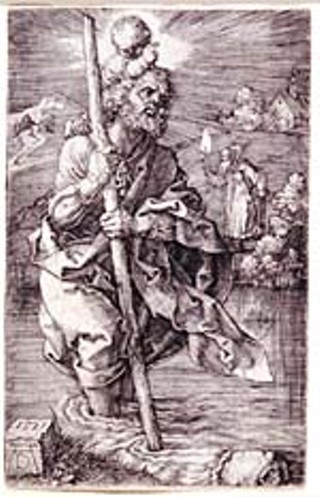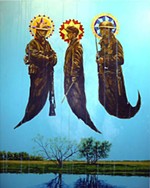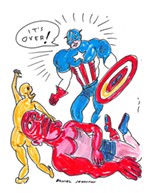‘"Prints from the Leo Steinberg Collection: Part II"’
Local Arts Reviews
Reviewed by Robert Faires, Fri., Dec. 5, 2003

"Prints From the Leo Steinberg Collection: Part II"
Blanton Museum of Art, through Jan. 4Need a quick vacation? Allow me to suggest my travel agent, Leo Steinberg. Well, he isn't a travel agent, strictly speaking, but through the astonishing collection of prints that he has donated to UT's Jack S. Blanton Museum of Art, a fraction of which is on display there now, he can send you to locales bucolic and tranquil or exotic and charged with mystery -- basically as far away as you might care to go.
The batch of prints currently hanging on the second floor of the museum is the second from Steinberg's 3,200-work collection to be displayed by the Blanton -- a hundred others were shown from January through July 2003 -- and while this selection may contain fewer obvious masterpieces, it is no less captivating or transporting. As before, curator Jonathan Bober has arranged the prints in a roughly chronological progression, allowing the viewer to follow the evolution of the art form -- in the advances of technology, development of subject matter, and refinement of style. Once again, you can wander from wall to wall, section to section, and see history in the making. And once again, you can lose yourself along the way in the many fascinating, exquisitely rendered worlds on display.
You can get lost in the worlds of biblical and mythological wonder. Here, in a sweepingly dramatic print by Giovanni Battista Scultori, are David and Goliath, the giant sprawled across the whole lower half of the picture, while above him stands the victorious David with an upraised sword almost as big as he is, ready to lop off his foe's head. There is St. Christopher, rendered by Albrecht Dürer in a piece as small as a playing card, but no less vivid for his size, the face solemn and patient and true, his hands firmly encircling the staff that steadies him as he fords the stream, an illuminating Christ child on his shoulders. Around the corner, in an engraving by Jan Saenredam, is Ceres, goddess of the harvest, cornucopia held lightly in her left hand while her right hand lingers suggestively just below her waist, a smooth and sensual figure blessing the work of three admiring peasants, all stout, ropy arms and plain faces.
You can get lost in the details of 16th- and 17th-century Flemish life: the family of bee keepers in their heavy hoods with netting over their faces, beating what appear to be colanders at a swarm overhead; the cannoneers with their weapons of mass destruction belching blinding flame into the night; the Swiss lansquenets carousing outside an inn, one firing a rifle at birds overhead, one groping under the skirt of a smiling maiden, and the happiest gent of them all balancing a mug of what is presumably some fermented beverage delicately on the tips of his fingers.
There's one wall of lovely Dutch pastorals from the 17th century: sheep like great pillows lying in the sun, a couple in a horse-drawn cabriolet lolling past a pasture of cattle grazing in the shade of trees, a pair of stocky horses standing beside an idle plow. Stare long enough -- and they invite staring -- and you almost begin to smell the fresh-cut hay and fertile soil.
Or you can get lost in the eyes of painters and prophets. On the southern side of the gallery, you find French and English prints from the 18th century onward, with their powerful, full-on portraits. You're almost compelled to lock gazes with Schmidt's Pierre Magnard, the artist's watery eyes studying you as a potential subject while he fingers his pen, or with Nanteuil and Edelnick's Moses, his stern stare -- every inch the lawgiver -- challenging you to obey the commandments carved in stone at his side.
Or, at any point through the exhibition, you can simply lose yourself in the lines. The intricacy of the line work draws you to look more closely at the prints, to appreciate the care with which the image has been created, the delicacy of this line, the intensity of that one. You can even find yourself following one line around and around, just marveling at its varying thickness and the part it plays in creating the image. Nowhere is this more striking than in The Sudarium, Claude Mellan's 1649 image of the face of Jesus mystically captured, as legend has it, on the cloth of a woman who wiped his face on the day of his crucifixion. In a feat of staggering technical virtuosity, Mellan created the entire, lovingly detailed face out of a single line starting in the center of the image on the tip of Jesus' nose and spiraling outward to the work's edges. It is emblematic of the way these prints pull you out of yourself and into their reality.
Anyone in need of a getaway is advised to book passage on this exhibition. Half an hour here can feel like four centuries away from one's hectic ordinary existence. Just be forewarned: Once you arrive, you may want this vacation to go on and on and on.










